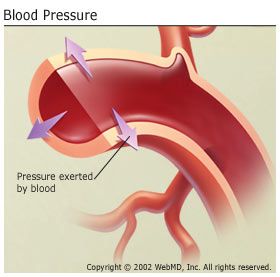http://www.webmd.com/heart/understanding-low-blood-pressure-basics?page=2
Understanding Low Blood Pressure - the Basics
What Is Low Blood Pressure?
Hypotension is the medical term for low blood pressure (less than 90/60) with no symptoms.
A blood pressure reading appears as two numbers. The first and higher of the two is a measure of systolic pressure, or the pressure in the arteries when the heart beats and fills them with blood. The second number measures diastolic pressure, or the pressure in the arteries when the heart rests between beats.
Normal blood pressure is usually in the range of 120/80 (systolic/diastolic). In healthy people, especially athletes, low blood pressure is a sign of good cardiovascular (heart and blood vessel) health. But low blood pressure can be a sign of an underlying problem -- especially in the elderly -- where it may cause inadequate blood flow to the heart, brain, and other vital organs.

Chronic low blood pressure with no symptoms is almost never serious. But health problems occur when blood pressure drops suddenly, and the brain is deprived of an adequate blood supply. This can lead to dizziness or lightheadedness. Sudden drops in blood pressure most commonly occur in someone who's rising from a prone or sitting position to standing. This kind of low blood pressure is known as postural hypotension, orthostatic hypotension, or neurally mediated orthostatic hypotension.
Postural hypotension is considered a failure of the autonomic nervous system -- the part of the nervous system that controls involuntary vital actions, such as the heartbeat -- to react appropriately to sudden changes. Normally, when you stand up, some blood pools in your lower extremities. Uncorrected, this would cause your blood pressure to fall. But your body normally compensates by sending messages to your heart to beat faster and to your blood vessels to constrict. This offsets the drop in blood pressure. If this does not happen, or happens too slowly, postural hypotension results.
The risk of both low and high blood pressure normally increases with age, due in part to normal changes during aging. In addition, blood flow in the brain declines with age, often as a result of plaque buildup in blood vessels. An estimated 10% to 20% of people over age 65 have postural hypotension.
What Causes Low Blood Pressure?
The cause of low blood pressure isn't always clear. It may be associated with the following:
- Pregnancy
- Hormonal problems such as an underactive thyroid (hypothyroidism), overactive thyroid (hyperthyroidism), diabetes, or low blood sugar (hypoglycemia)
- Over-the-counter medications
- Overdose of high blood pressure drugs
- Heart failure
- Heart arrhythmias (abnormal heart rhythms)
- Widening, or dilation, of the blood vessels
- Heat exhaustion or heat stroke
- Liver disease
What Causes a Sudden Drop in Blood Pressure?
Sudden drops in blood pressure can be life-threatening. Causes of this type of hypotension include:
- Loss of blood from bleeding
- Low body temperature
- High body temperature
- Heart muscle disease causing heart failure
- Sepsis, a severe blood infection
- Severe dehydration from vomiting, diarrhea, or fever
- A reaction to medication or alcohol
- A severe allergic reaction, called anaphylaxis
-
Understanding Low Blood Pressure - the Basics
(continued)What Causes Low Blood Pressure? continued...
Who Gets Postural Hypotension?
Postural hypotension, which is low blood pressure when standing up suddenly, can happen to anyone for a variety of reasons, such as dehydration, lack of food, prolonged standing in the heat, or being overly fatigued. It can also be influenced by genetic make-up, aging, medication, dietary and psychological factors, and acute triggers, such as infection and allergy.
Postural hypotension occurs most frequently in people who are taking drugs to control high blood pressure (hypertension). It can also be related to pregnancy, strong emotions, hardening of the arteries (atherosclerosis), or diabetes. The elderly are particularly affected, especially those who have high blood pressure or autonomic nervous system dysfunction.
Hypotension after meals is a common cause of dizziness and falls after eating. It’s believed to be caused by blood pooling into he vessels of the stomach and intestines.
Several drugs are commonly associated with postural hypotension. These medications can be divided into two major categories:
- Drugs used to treat high blood pressure, such as diuretics, beta-blockers, calcium-channel blockers, and angiotensin-converting enzyme (ACE) inhibitors.
- Drugs that have hypotension as a side effect, including nitrates, drugs for Parkinson's disease, antipsychotics, neuroleptics, anti-anxiety agents, sedative-hypnotics, and tricyclic antidepressants.
Common causes of naturally occurring postural hypotension include:
- Dehydration and electrolyte loss, which may result from diarrhea, vomiting, excessive blood loss during menstruation, or other conditions
- Age-associated decline in blood pressure regulation, which may be worsened by certain health conditions or medications
Certain diseases can cause postural hypotension. Common causes of pathologic (attributable to a disease) postural hypotension include:
- Central nervous system disorders, such as Shy-Drager syndrome or multiple system atrophy
- Nerve problems, such as peripheral neuropathy or autonomic neuropathy
- Cardiovascular disorders
- Alcoholism
- Nutritional diseases
Less common diseases that can cause postural hypotension include amyloidosis (caused by deposits of a waxy substance called amyloid in the body), vitamin deficiencies, spinal cord injuries, and neuropathies associated with cancer, particularly lung cancer or pancreatic cancer.


 留言列表
留言列表
